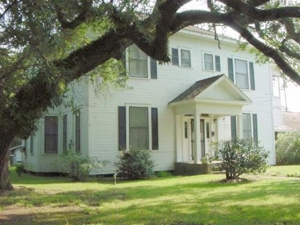
Arthur “Gus” Augustus and Martha Jane Williams Fluitt built this stately home at 210 West LeBlanc Street between 1909 and 1912 on land purchased from Edgewood Land and Logging Company.
The house is located on a portion of land, which originally contained 161 acres that had been purchased by Edward A. and Edward F. Brackenridge from the U. S. Government around 1883. The Fluitts lived here with their children, Frank, Clyde, Fred, Bob, Arthur and Mona. The house is also associated with one of DeQuincy’s earliest physicians, Dr. Samuel Fluitt.
During the 1918 “Big Storm” hurricane which devastated southwest Louisiana, the exterior of the house was extensively damaged and the upper and lower porches, which originally surrounded the house, were blown away. The story is told that Gus tied his wife, Martha, and all the children to a large pine tree with ropes for fear they were going to be harmed.
Subsequent owners were Mr. and Mrs. Raymond C. Willrich and Mr. and Mrs. William W. Stanfield. Mrs. Evelyn Abdalla purchased the property in 1945, and her son, Abraham Abdalla, and daughter, Sadie Abdalla, own it today.
The architectural style of this majestic house is Colonial Revival. The entry portico is of a Federal design and Doric columns support its vaulted pediment. Entrance to the lower floor is made through a handsome front door with sidelights and a rectangular fanlight. The grand entry foyer is flanked by an elegant front parlor and formal dining room on either side, with a center parlor known as the greeting parlor, and a kitchen in the rear.
The second floor contains five bedrooms, a bath, and rear and side screened “sleeping” porches.
The third floor attic space created by the high pitch of the roof was designed with servants’ quarters in mind, but has been used for storage.
The house is rich in architectural detail. The woodwork and flooring are built of heart pine. The downstairs rooms have 12′ ceilings and each entryway consist of French doors with interior transoms.
The ceilings on the second floor have 10′ ceilings. Most of the windows have original glass with the slight imperfections of the era. The open stairway in the foyer is especially impressive. A fireplace built of bricks salvaged from New Orleans serves the front parlor.
With over 4000 square feet, the Fluitt – Abdalla House was no doubt the largest in the area when it was originally built. Massive live oak trees surrounded the site long before the house was built and it is rumored that confederate troops camped out here on their way to a battle at Sabine Pass.
Two large oaks remain: the Abdalla Oak in front of the house and the Crawford Oak in the rear are registered with the National Live Oak Society and are two of the largest specimens in Calcasieu Parish.
